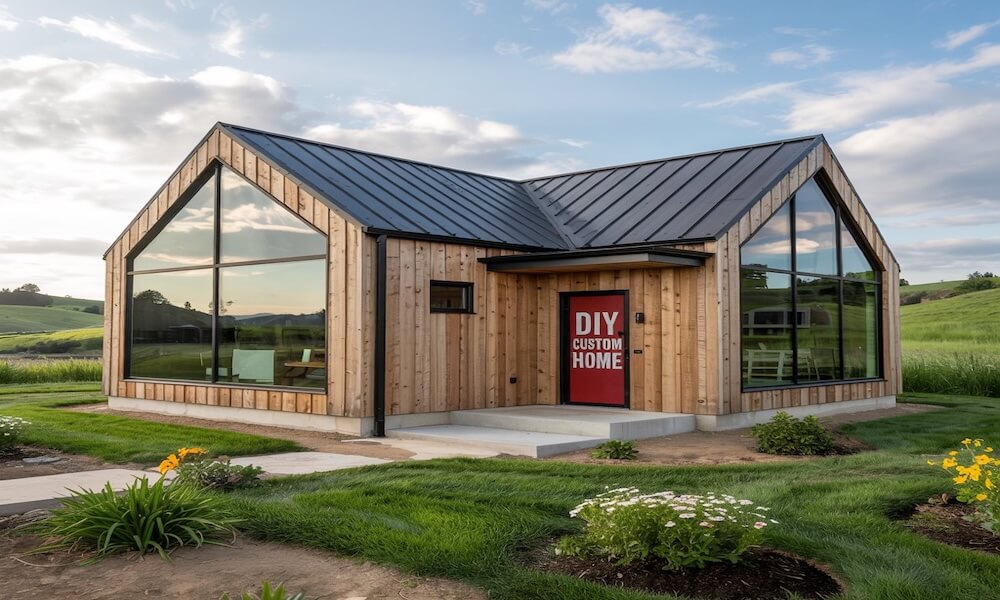DIY Options
DIY Options for Custom Homes
Building a custom home is often seen as a massive undertaking best left to professionals. While it’s true that tasks like structural framing, electrical wiring, and plumbing should be handled by licensed contractors, there are still plenty of do-it-yourself (DIY) options for homeowners looking to get involved in the process. From planning and design to interior finishes, savvy homeowners can save thousands of dollars and add deeply personal touches to their home by taking on certain tasks themselves.
In this guide, we’ll explore realistic DIY options for your custom home project, the pros and cons, and how to know what’s safe and smart to handle on your own.

1. Planning and Design: Laying the Foundation Yourself (Metaphorically)
Before a single nail is hammered, your home needs a design. While many people hire architects or home designers, you can significantly reduce costs by using DIY design software like SketchUp, RoomSketcher, or Home Designer Suite.

DIY Opportunities:
- Creating your own floor plan and layout ideas.
- Designing room configurations, window placements, and traffic flow.
- Using Pinterest, Houzz, and other platforms to build visual style boards for inspiration.
Benefits:
- Saves $5,000–$20,000 in design fees.
- Gives you creative control.
- Helps communicate your vision clearly to contractors.
Pro Tip:
Even if you design the initial concept yourself, consider having a professional review your plans for feasibility, safety, and local code compliance.
2. Site Prep and Landscaping
If you have access to equipment (or can rent it affordably), some site preparation tasks can be tackled DIY-style, especially for land that doesn’t require major grading.
DIY Opportunities:
- Clearing brush or small trees.
- Installing erosion control (like straw wattles or silt fencing).
- Planting trees, shrubs, and building garden beds after construction.
- Building simple retaining walls or gravel pathways.
Benefits:
- Reduces labor costs.
- Allows for more flexible landscaping decisions over time.
Caution:
Leave large excavation, grading, or anything involving heavy machinery to professionals. Mistakes can be costly and dangerous.
3. Interior Painting and Finishes
Interior painting is one of the most common DIY jobs — and one of the most budget-friendly ways to customize your home.
DIY Opportunities:
- Painting walls, ceilings, and trim.
- Installing baseboards and moldings.
- Staining or painting built-in shelves or cabinetry.
Benefits:
- Professional painters can charge thousands — DIY saves big.
- Easy to update later as styles change.
- A satisfying weekend project.
Pro Tip:
Invest in good quality brushes, rollers, and painter’s tape. Prep is 80% of the job — don’t skip cleaning and priming surfaces.
4. Flooring Installation
Depending on the material, some flooring types are extremely DIY-friendly — especially floating floors that click together.

DIY Opportunities:
- Laminate, vinyl plank, and engineered wood flooring.
- Tile in small areas (bathrooms or backsplashes).
Benefits:
- Save on installation fees ($2–$8 per square foot).
- Learn a new skill that can be used in future upgrades or repairs.
Caution:
Carpet installation, refinishing hardwood, and large-scale tiling should usually be left to pros unless you have experience.
5. Cabinet and Vanity Installation
Pre-assembled cabinets from IKEA, Lowe’s, or online providers make it possible to install your own kitchen or bathroom cabinetry.
DIY Opportunities:
- Mounting wall and base cabinets.
- Assembling flat-pack units.
- Installing countertops (laminate or butcher block — leave stone to pros).
Benefits:
- Saves labor costs ($2,000+).
- Lets you choose creative storage options or customize interiors.
Challenges:
Precision is critical — if cabinets aren’t level, everything else (like countertops) will be off.
6. Lighting and Fixtures
While hardwiring should be done by a licensed electrician, you can install or swap out light fixtures yourself once the wiring is in place.
DIY Opportunities:
- Installing ceiling fans, chandeliers, or wall sconces.
- Replacing faucets, showerheads, and cabinet hardware.
Benefits:
- Easy to refresh the style of a space later on.
- Gives you more freedom to shop for deals and unique fixtures.
Pro Tip:
Always turn off the breaker before working on electrical fixtures. Use a voltage tester to double-check safety.
7. Trim, Wainscoting, and Decorative Features
Custom woodwork adds character to any home — and with a few tools and patience, you can do much of it yourself.

DIY Opportunities:
- Shiplap accent walls.
- Board-and-batten paneling.
- Crown molding and decorative trim.
Benefits:
- Major design impact with a low cost.
- Endless opportunities for personalization.
Tools Needed:
- Miter saw, nail gun, level, caulk, and painter’s putty.
8. Storage and Built-Ins
Many homeowners dream of built-in bookshelves, mudroom cubbies, or custom closets. With a little creativity and some basic woodworking knowledge, these are great DIY weekend projects.
DIY Opportunities:
- Closet systems (many brands offer DIY kits).
- Bookshelves and entertainment centers.
- Garage shelving and workbenches.
Benefits:
- Maximizes your space.
- Adds resale value and visual appeal.
9. Smart Home Integration
Today’s smart home gadgets are designed with DIYers in mind.
DIY Opportunities:
- Installing smart thermostats, lights, and cameras.
- Creating home automation scenes and routines.
- Running low-voltage cables (speaker wire, ethernet, etc.).
Benefits:
- Customizable to your exact preferences.
- Affordable compared to hiring AV professionals.
